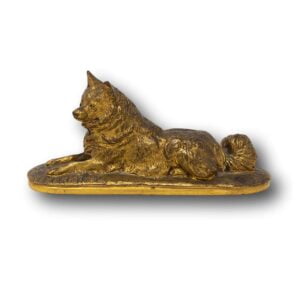Description
A rare Meiji period vase with simulated iron finish and intricate mixed-metal inlays
From our Japanese collection, we are pleased to present this Japanese Simulated Iron Bronze Vase by Miyabe Atsuyoshi, dating to the late 19th century Meiji period, circa 1890.
This highly unusual example features a distinctive rough simulated iron finish on a bronze base, a remarkable technique that sets it apart from more traditional bronzes of the period. The surface is finely decorated with takazogan inlays in copper, silver, gilt, and shakudo, illustrating a serene naturalistic scene of crane birds perched on the branches of a snow-covered willow tree, with others captured in flight.
The design reflects the Japanese Meiji fascination with nature, combining both texture and precious metals to create striking contrast and depth. The reverse is signed to the base 大日本京都住 宮部篤良 “ Dai Nihon Kyōto jū Miyabe Atsuyoshi” with Kao, confirming its origin and maker.
This vase is an outstanding representation of the Kyoto school of bronze work under Miyabe Atsuyoshi, known for his technical mastery and interpretation of natural themes. A superb piece for collectors of Japanese bronzes, Meiji period art, and mixed-metal decorative wares.
Miyabe Atsuyoshi 宮部篤良
Miyabe Atsuyoshi was a Kyoto bronze artist of the Otsuki School and pupil of Shinoyama Tokuoki, was active during the Meiji period. Known for his intricate inlay techniques and naturalistic themes, he exhibited internationally, including at the 1904 St. Louis World’s Fair.
For further information see our makers and retailers page on Miyabe Atsuyoshi.
BRONZE
Bronze has been one of the most widely used materials in art and design for centuries, valued for its strength, durability, and ability to capture fine detail. Popular from ancient civilisations to the 19th century, bronze has been used for statues, decorative objects, and functional pieces alike. In the late 19th century, artists in Vienna, including Franz Xaver Bergmann, perfected the technique of cold-painting, adding rich layers of colour to bronze without firing. This innovation, along with the timeless appeal of bronze’s patina and texture, ensures that antique bronze objects remain highly collectible today.
For further information please see our article Bronze Sculpture: History, Composition, and Casting Techniques.
MEIJI PERIOD (1868-1912)
The Meiji era marked Japan’s transformation into a modern nation and a golden age of decorative arts. With the end of samurai rule and Japan’s opening to the West, artisans produced works of exceptional quality for both domestic and international audiences. Supported by the government through world fairs and Imperial commissions, Japanese lacquerware, cloisonné, satsuma ceramics, bronzes, and ivory carvings reached collectors worldwide. Many leading artists of the time, including Makuzu Kozan and Namikawa Yasuyuki, were honoured as Imperial Household Artists, ensuring the Meiji period remains one of the most celebrated eras of Japanese art.
For further information please see our article Japanese Meiji Period: Art, Collecting, and Cultural Transformation.
MEASUREMENTS
22cm High x 8.5cm Wide (8.66 x 3.35 Inches)
CONDITION
Very Good antique condition
With every purchase from Jacksons Antique, you will receive our latest product guide, certificate of authenticity, full tracking information so you can monitor your shipment from start to finish and our personal no-hassle, money-back policy giving you that extra confidence when purchasing. Don’t forget to sign up to our free monthly newsletter for 10% off your first online purchase.
























